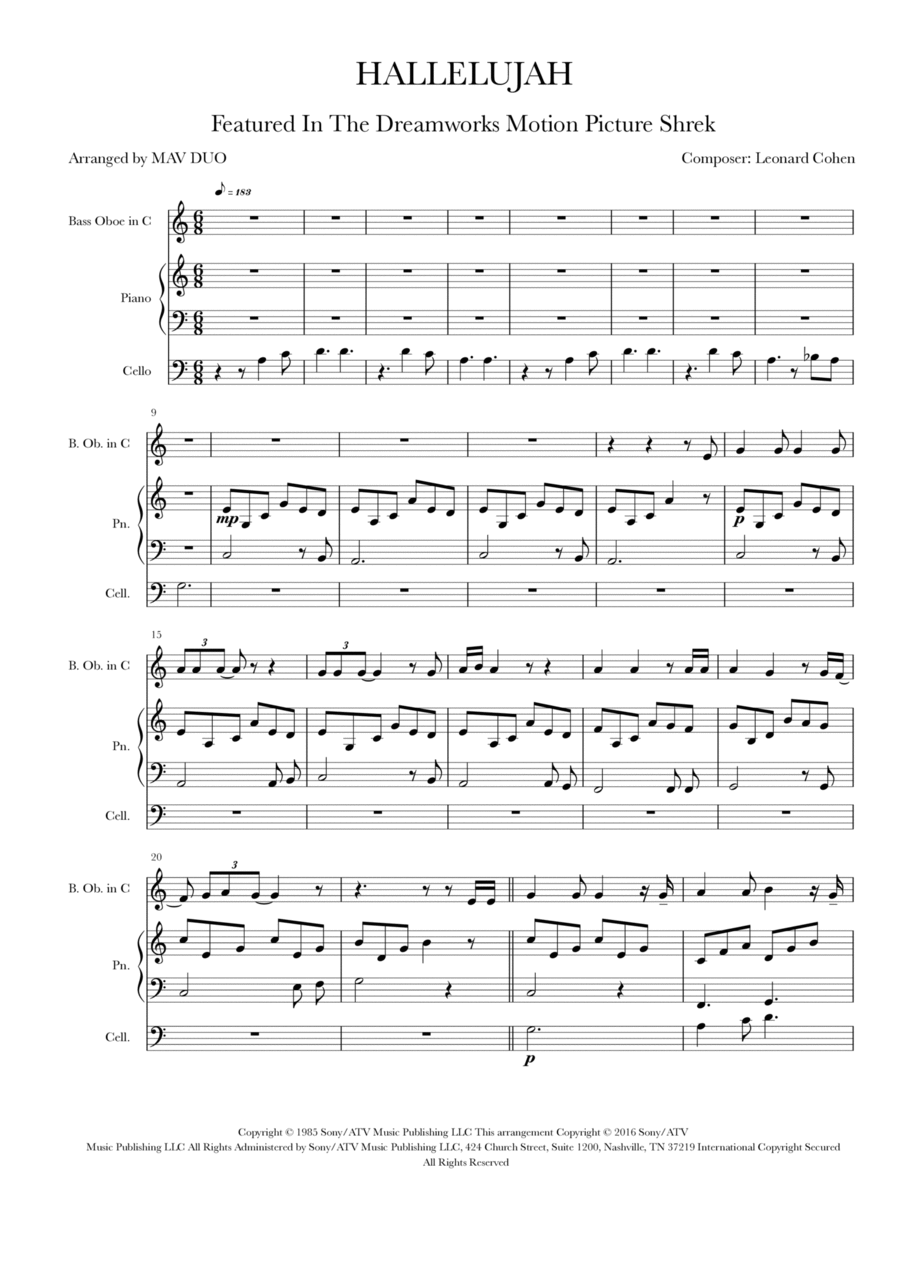Piano,Voice Duet Mezzo-Soprano Voice,Piano,Tenor Voice - Level 2 - Digital Download SKU: A0.1262601 By Andrea Bocelli. By Leonard Cohen. Arranged by Mav Duo. Film/TV,Folk,Pop,Rock. 6 pages. Musicial #855617. Published by Musicial (A0.1262601). A Triumphant Harmony: A Captivating Three-Instrument Arrangement of Leonard Cohen's Hallelujah from Shrek, for Piano, Male Voice, and CelloPrepare to be swept away by a harmonious tapestry of sound as three exceptional instruments unite in a breathtaking arrangement of Leonard Cohen's iconic masterpiece, Hallelujah. This captivating rendition, made famous by its inclusion in the beloved film Shrek, combines the power of piano, the soulful resonance of a male voice, and the enchanting melodies of the cello, creating an extraordinary musical experience that will leave you spellbound.Immerse yourself in the profound beauty of Hallelujah, a composition by the legendary Leonard Cohen, as the piano sets the foundation with its evocative chords, while the male voice, with its deep and resonant timbre, breathes life into the poignant lyrics. The cello, with its rich and soul-stirring tones, adds an additional layer of emotional depth, weaving intricate melodies that echo with passion and yearning.Crafted with meticulous attention to detail, this three-instrument arrangement showcases the timeless power of Leonard Cohen's Hallelujah in a unique and mesmerizing light. The piano, male voice, and cello intertwine seamlessly, creating an exquisite harmony that embodies the profound emotions and spiritual depth of the original composition, which gained widespread recognition through its inclusion in the renowned film Shrek.Whether you are an accomplished pianist seeking an awe-inspiring collaboration, a talented male vocalist eager to showcase your vocal prowess, or a skilled cellist searching for a captivating arrangement, this three-instrument ensemble is an absolute must-have. It offers an extraordinary opportunity to delve into the rich layers of Leonard Cohen's Hallelujah and to create a performance that resonates with raw emotion and musical brilliance, while also evoking the nostalgia of its inclusion in Shrek.As the piano chords resound, the male voice weaves its own tale of longing and devotion, while the cello adds a touch of ethereal beauty. The combination of these three instruments unlocks a profound emotional journey, where each note becomes a vessel for hope, solace, and triumph, resonating with the memories and emotions associated with the beloved film Shrek.This three-instrument arrangement of Leonard Cohen's Hallelujah, famous for its inclusion in Shrek, is a testament to the timeless appeal and universal resonance of music. It invites you to experience the transformative power of this iconic composition, as the piano, male voice, and cello intertwine to create an immersive musical experience that transcends boundaries and awakens the deepest corners of the soul.Don't miss this extraordinary opportunity to own a piece of musical brilliance. Order your three-instrument arrangement of Leonard Cohen's Hallelujah today and let the triumphant harmonies fill your heart and soul. Embrace the captivating synergy of the piano, male voice, and cello, and let the music unfold, carrying you on a journey of deep introspection, spiritual awakening, and overwhelming beauty, while also invoking the nostalgia and sentimental attachment associated with its inclusion in Shrek.Keywords: three-instrument arrangement, Hallelujah, Leonard Cohen, captivating musical experience, harmonious tapestry, profound beauty, evocative chords, soulful resonance, emotional depth, unique and mesmerizing, awe-inspiring collaboration, raw emotion, musical brilliance, transformative power, universal resonance, triumphant harmonies, captivating synergy, deep introspection, spiritual awakening, overwhelming beauty, Shrek.
